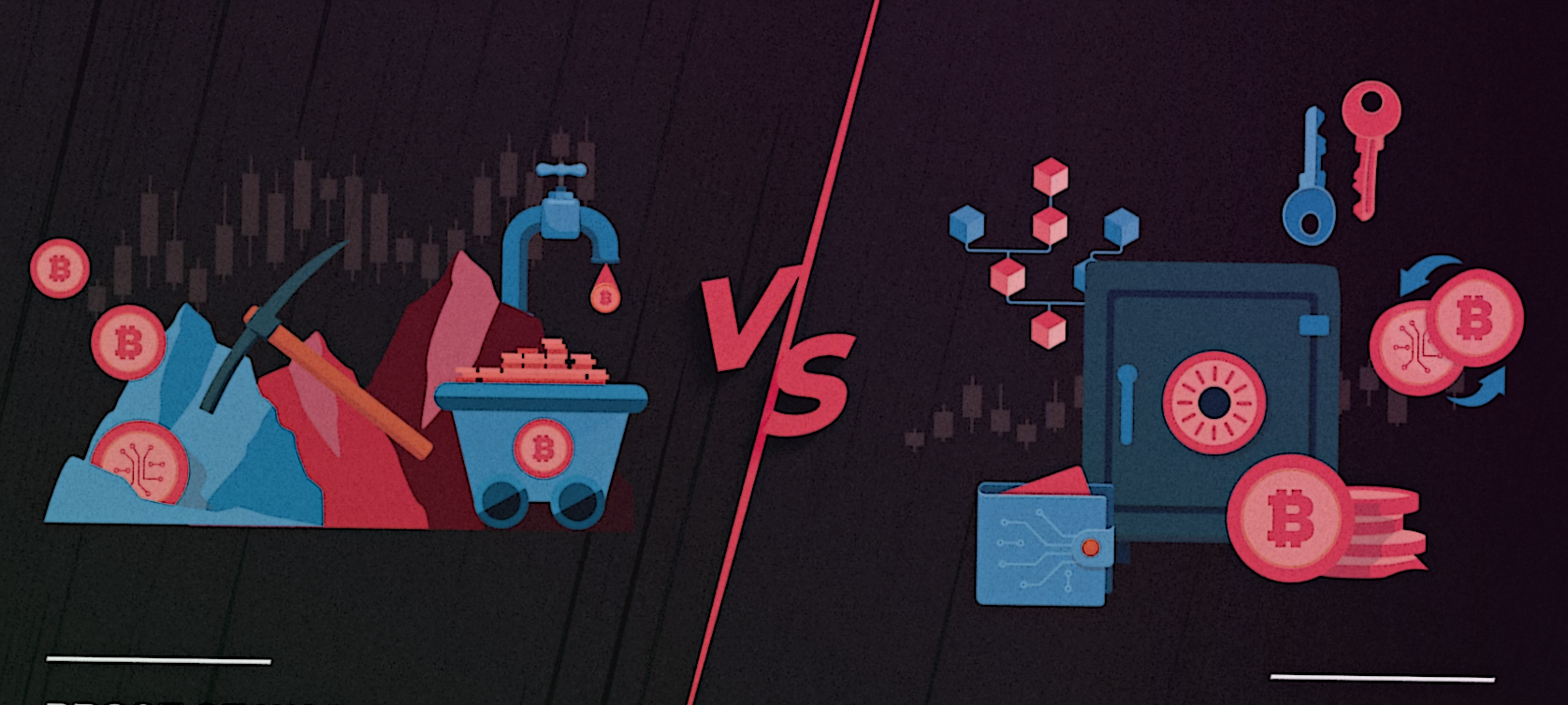Staking vs. Mining: Which is Better for Your Crypto Portfolio?

Staking is growing in popularity every day. It is this that evokes the interest of the large and institutional investors in this earning method, in connection with a lot of unique features nowadays about methods of daily earning.
The main question is, what is staking?
Therefore, staking is passive earning in which a user has coins following an algorithm based on Proof of Stake to make the blockchain network work.
It’s more similar to a loan in that they can make a profit out of it and receive part of the enormous profit. So, this is what gives a right to receive profit. You can use it only with cryptocurrencies that operate on the PoS algorithm, such as EOS, Tezos, TRON, and Cosmos, and in the future, the largest altcoin by market capitalization, Ethereum. More details about staking.

📖 Staking completely supplants mining. Therefore, you can mine new blocks without burning computational power this way.
Simply put, staking underlies everything happening on the blockchain and network servicing. For this, holders of digital coins are rewarded. The more tokens one has, the greater the probability that a new block author will be that person.
What is Mining?
Mining is the process of producing digital money using special equipment.
Mining is the design of blockchain engineering, and it works by attaching blocks with information related to a transaction already done, thereby forming a never-ending and sequential chain or a so-called blockchain.
📖 To attach a block, one must solve a specific mathematical problem by decrypting the cryptocurrency algorithm.
In a word, that is the task of miners and their specialized equipment. The one who finds the correct answer receives a reward in digital coins. However, the fact that more miners are looking for an answer to the question means that the probability of correctly finding the answer increases, but the reward value decreases.

How Staking Differs from Mining
Staking
A user simply holds his coins for the network and, in return, receives some newly minted coins for free. This process secures the network.
Mining
Solving complex mathematical problems requires high levels of computing power. Once you find a solution, it adds new blocks to the blockchain, and you receive a cryptocurrency award.
Staking would require coins, while mining would need equipment. One can also mine without purchasing by using cloud mining. That means renting hardware.
Type of Staking
- Locked: is when you can lock some of your coins for some time; within that period, your coins cannot be moved. From doing so, you receive rewards in the form of additional coins.
- Flexible: allows you to move your coins whenever you wish. You indeed have more flexibility, but you may receive fewer rewards.
- DeFi: is when you stake within decentralized applications and receive interest or other coin tokens.

What Are the Risks?
Investing in the cryptocurrency market is risky, and this doesn’t change even when you stake your crypto. For example, currently, surfacing is a staking protocol that offers up to 15% APY, which is pretty wise if you are looking for passive income. Such yield is the common offering to staking investors. But in case the price of the asset falls, say, by 50% in a year, which is very common in the crypto market, the speaker does not lose his asset; however, the value of those assets falls immensely.
Absence of Liquidity
One of the main reasons you might be concerned about putting your crypto into staking is lack of liquidity. Liquidity, in the simplest terms, means the possibility of easy selling or exchanging of assets in the market at any time without crashing it. Thus, if you stake assets with relatively low market capitalization, you’re at risk because of poor liquidity.
Lock-Up Period
The lock-up period is when one holds, and it’s impossible to withdraw or transfer any of the coins, be it Tron or Cosmos. While this happens, the blockchain integrity for that coin is preserved within the system. This represents one of the significant risks with staking. For instance, if TRON is staked and the price goes down, then you will lose some amount of money. You can’t unlock your assets ahead of time to hedge the losses. It is better to stake those coins that don’t have strict lock-up rules to have constant access to your funds. Such coins are collected in the [article](Link to the source).
Interest Payments Frequency
Some staking protocols do not support the payment of interest daily. The fees are monthly or even quarterly and within a year. It would be better to stake coins for protocols making daily payments to their rewards.
Costs of Validators
Another example of the risky nature of staking is that PoS mining clings to the cost of staking and third-party services, which can hit profits hard. At first, your validator node will require money for equipment and electricity. Placing coins with a third-party provider usually costs them a few percent of the staking rewards.
How to Start Staking Step
- Choose a Wallet You will need a wallet or platform that supports staking.
- Choose a Coin After conducting research on projects, choose a coin to stake. It is better to focus on the team, technology, and the community.
- Buy the Coin Buy the chosen coin from the exchange.
- Choose the Type of Staking Choose one of the three types: fixed, flexible, and DeFi.
ADS
Pros and Cons of Staking
The process of staking attracts many investors in the crypto space to earn passive income. However, like any other activity in the investment niche, it has pros and cons. Let’s have a closer look.
Pros of Staking
- Easy to Start: It is simple to start earning rewards. You only need to buy and stake the desired number of coins in your account. This is particularly relevant to flexible and DeFi staking, where rewards accrue quickly.
- Accessibility: Staking does not require expensive mining machines that consume a lot of power. You only need to hold a certain quantity of cryptocurrency and have an internet connection.
- Network Benefit: By staking your coins, you support the organization and security of the entire blockchain. The more stakes, the higher the network’s decentralization and resistance to fraud.
- Potential High Returns: Staking can offer a potential annual percentage yield of 5-20%, or even more, depending on the chosen cryptocurrency and staking conditions. This is highly profitable compared to traditional bank deposits.
Cons of Staking
- Cryptocurrency Volatility: The prices of digital assets can fluctuate significantly, affecting the value of your investment and returns. In case of a market downturn, there is a risk of partial loss of the staked funds.
- Locking of Funds: During the staking period, you cannot use your coins as they remain locked, reducing your financial flexibility, even in emergencies.
- Risks with Providers: If you stake through third-party platforms or pools, choose reputable providers to avoid scammers and the risk of losing your funds.
- Complexity for Beginners: Is easier than mining but still requires understanding wallets, cryptocurrency transactions, and security. Beginners need time to grasp these concepts.
- Fees and Expenses: Remember to account for fees from exchanges, platforms, and networks when transferring funds. In some cases, there could be additional costs, such as maintaining a masternode for certain coins.
Conclusion
Staking is an attractive way to earn profits passively through cryptocurrency, offering high returns while contributing to the security and efficiency of the blockchain network. However, it is also inherently risky due to its volatility, locking periods, and potential provider fraud. Understanding these factors and making informed decisions can help investors maximize the benefits while minimizing its drawbacks. Whichever option you choose, ultimately you are likely aiming for maximum profit from your investments. Therefore, I also recommend reading the articles “The Best Crypto to Buy Right Now” and “How to Find an Altcoin That Will Bring 1,000% Profit“.





